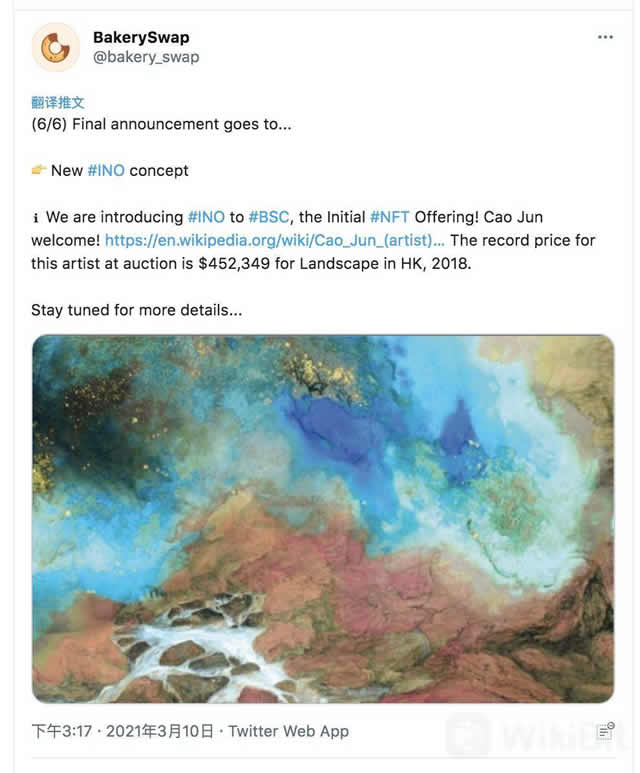php editor Xigua will take you to understand the new way of playing NFT, INO. INO is the abbreviation of Initial NFT Offering, which is a new method of raising funds based on NFT technology. Different from traditional ICO (Initial Coin Offering), INO represents the equity of the project by issuing NFT and uses it as a way to raise funds. This new way of playing allows investors to participate in the early financing of the project by purchasing the NFT of the project, and at the same time enjoy the unique value brought by the NFT. By understanding INO, you can better grasp this innovative investment opportunity and achieve better investment returns.

Let us use these two examples to first understand the concept of INO.
On March 10, Binance Smart Chain (BSC) DEX project BakerySwap announced the introduction of INO gameplay. Cao Jun, a Chinese artist, became the first publisher to use this gameplay. One of his landscape paintings was auctioned in 2018 and sold for US$452,349.

As of now, the information about this INO is still very limited, but it is speculated that it is a common way to play new games.
Another project that will introduce the INO concept is the NFT index fund project NFTX.
Recently, DeFi Pulse co-founder Scott Lewis mentioned the idea of INO in his proposed NFTX V2 design concept.

The following is the translation of the idea:
This is just an idea at the moment, and this idea will change based on feedback.
Features:
Time-locked redemption only mode;
INO (Initial NFT issuance) feature;
Content creators can place a series of NFTs into A vault then distributes ERC20 according to their choice (airdrop, uniswap listing, token sale contract) and starts a time period during which ERC20 holders can burn 1 ERC20 token and withdraw from the vault Redeem 1 random NFT.
After the time lock-only exchange mode is completed, users can start depositing and redeeming NFT normally.
Fees Parameters
DAO can set fee parameters for withdrawals and deposits for all NFTX D1 vaults, as well as target withdrawal fees (fees for redeeming specific items from the vault). Fees are denominated in vault ERC20 tokens.
The 1% deposit fee means that every time an NFT is deposited, the NFT depositor will receive 0.99 ERC20 tokens.
The 1% withdrawal fee (a higher or lower fee can be set for each vault, the default is 0%) means that NFT storage users must spend 1.01 ERC20 generation for each NFT redeemed coins (expect withdrawal fees to be set to 0 in most cases).
The 10% target withdrawal fee means that NFT storage users must spend 1.1 ERC20 tokens to redeem a specific NFT.
Fees Details
NFT Issuers
For issuers using the NFTX protocol for initial distribution, they can choose an address to receive the 40% fee.
DAO Treasury
For treasury activated by the issuer, DAO will charge 40% fee. For non-issuer activated vaults, the DAO will charge 80%. (Alternatively, the fee can be set to 0%, with 60% allocated to the liquidity provider LP to earn NFTX).
Liquidity Provider (LP)
Liquidity Provider (LP) who has pledged NFTX/D1 LP tokens in the staking contract designated by DAO will be eligible to claim the remaining 20% fee.
Summary:
Judging from the above two examples, INO’s gameplay is not unfamiliar at all. It is just an ERC 20 type token that we are familiar with before. Switching to NFT art works, in the short term, this may just be a way to cater to market speculation needs.
As for whether these gameplay methods can attract real users, we need to let the market tell us the answer.
The above is the detailed content of Quickly understand the new way of playing NFT, INO, do you know?. For more information, please follow other related articles on the PHP Chinese website!




